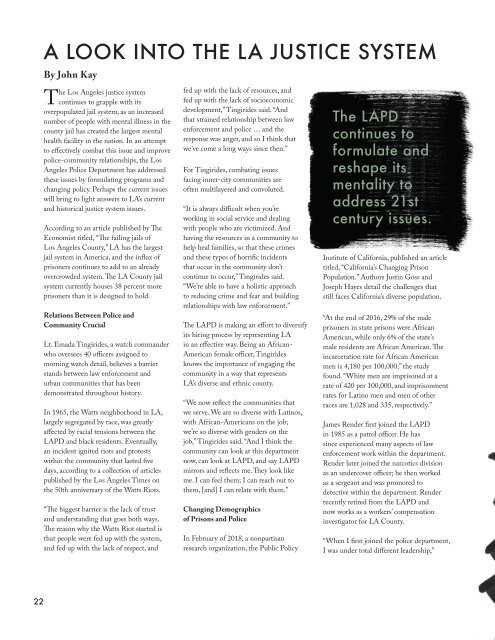The Point: Spring 2018
Spring 2018 | Volume 13 | Issue 2
Spring 2018 | Volume 13 | Issue 2
- No tags were found...
You also want an ePaper? Increase the reach of your titles
YUMPU automatically turns print PDFs into web optimized ePapers that Google loves.
A LOOK INTO THE LA JUSTICE SYSTEM<br />
By John Kay<br />
<strong>The</strong> Los Angeles justice system<br />
continues to grapple with its<br />
overpopulated jail system, as an increased<br />
number of people with mental illness in the<br />
county jail has created the largest mental<br />
health facility in the nation. In an attempt<br />
to effectively combat this issue and improve<br />
police-community relationships, the Los<br />
Angeles Police Department has addressed<br />
these issues by formulating programs and<br />
changing policy. Perhaps the current issues<br />
will bring to light answers to LA’s current<br />
and historical justice system issues.<br />
According to an article published by <strong>The</strong><br />
Economist titled, “<strong>The</strong> failing jails of<br />
Los Angeles County,” LA has the largest<br />
jail system in America, and the influx of<br />
prisoners continues to add to an already<br />
overcrowded system. <strong>The</strong> LA County jail<br />
system currently houses 38 percent more<br />
prisoners than it is designed to hold.<br />
Relations Between Police and<br />
Community Crucial<br />
Lt. Emada Tingirides, a watch commander<br />
who oversees 40 officers assigned to<br />
morning watch detail, believes a barrier<br />
stands between law enforcement and<br />
urban communities that has been<br />
demonstrated throughout history.<br />
In 1965, the Watts neighborhood in LA,<br />
largely segregated by race, was greatly<br />
affected by racial tensions between the<br />
LAPD and black residents. Eventually,<br />
an incident ignited riots and protests<br />
within the community that lasted five<br />
days, according to a collection of articles<br />
published by the Los Angeles Times on<br />
the 50th anniversary of the Watts Riots.<br />
“<strong>The</strong> biggest barrier is the lack of trust<br />
and understanding that goes both ways.<br />
<strong>The</strong> reason why the Watts Riot started is<br />
that people were fed up with the system,<br />
and fed up with the lack of respect, and<br />
fed up with the lack of resources, and<br />
fed up with the lack of socioeconomic<br />
development,” Tingirides said. “And<br />
that strained relationship between law<br />
enforcement and police … and the<br />
response was anger, and so I think that<br />
we’ve come a long ways since then.”<br />
For Tingirides, combating issues<br />
facing inner-city communities are<br />
often multilayered and convoluted.<br />
“It is always difficult when you’re<br />
working in social service and dealing<br />
with people who are victimized. And<br />
having the resources in a community to<br />
help heal families, so that these crimes<br />
and these types of horrific incidents<br />
that occur in the community don’t<br />
continue to occur,” Tingirides said.<br />
“We’re able to have a holistic approach<br />
to reducing crime and fear and building<br />
relationships with law enforcement.”<br />
<strong>The</strong> LAPD is making an effort to diversify<br />
its hiring process by representing LA<br />
in an effective way. Being an African-<br />
American female officer, Tingirides<br />
knows the importance of engaging the<br />
community in a way that represents<br />
LA’s diverse and ethnic county.<br />
“We now reflect the communities that<br />
we serve. We are so diverse with Latinos,<br />
with African-Americans on the job;<br />
we’re so diverse with genders on the<br />
job,” Tingirides said. “And I think the<br />
community can look at this department<br />
now, can look at LAPD, and say LAPD<br />
mirrors and reflects me. <strong>The</strong>y look like<br />
me. I can feel them; I can reach out to<br />
them, [and] I can relate with them.”<br />
Changing Demographics<br />
of Prisons and Police<br />
In February of <strong>2018</strong>, a nonpartisan<br />
research organization, the Public Policy<br />
<strong>The</strong> LAPD<br />
continues to<br />
formulate and<br />
reshape its<br />
mentality to<br />
address 21st<br />
century issues.<br />
Institute of California, published an article<br />
titled, “California’s Changing Prison<br />
Population.” Authors Justin Goss and<br />
Joseph Hayes detail the challenges that<br />
still faces California’s diverse population.<br />
“At the end of 2016, 29% of the male<br />
prisoners in state prisons were African<br />
American, while only 6% of the state’s<br />
male residents are African American. <strong>The</strong><br />
incarceration rate for African American<br />
men is 4,180 per 100,000,” the study<br />
found. “White men are imprisoned at a<br />
rate of 420 per 100,000, and imprisonment<br />
rates for Latino men and men of other<br />
races are 1,028 and 335, respectively.”<br />
James Render first joined the LAPD<br />
in 1985 as a patrol officer. He has<br />
since experienced many aspects of law<br />
enforcement work within the department.<br />
Render later joined the narcotics division<br />
as an undercover officer; he then worked<br />
as a sergeant and was promoted to<br />
detective within the department. Render<br />
recently retired from the LAPD and<br />
now works as a workers’ compensation<br />
investigator for LA County.<br />
“When I first joined the police department,<br />
I was under total different leadership,”<br />
22




